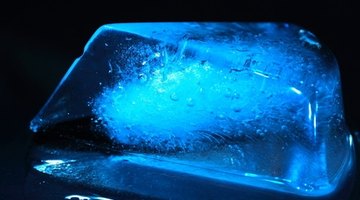What Causes the Cooling Effect Inside a Refrigerator?
You know that keeping your food in the refrigerator keeps it cool, but you may not have considered how it manages to do it. The process involves physics and the controlled movement of a complex chemical, but it is actually very easy to explain. By circulating this chemical through a repeating cycle, your refrigerator can remain cold for many years. This cold air will ensure your food remains safe to eat by preventing bacterial growth, and it will keep your frozen items in storage almost indefinitely.
Refrigerant Is Compressed

A refrigerant in gas form, HFC-134a is generally the cooling agent used in modern refrigerators. Older models used Chloro-Fluoro-Carbon (CFC), but it was found to be harmful to the environment. When HFC-134a is compressed, it heats up. It passes through the warm coils on the outside of the refrigerator and passes its heat into the air in the room though a process known as thermodynamics. Thermodynamics is when a hot and cold substance are in close proximity to one another; the cooler substance will get warmer, and the hot substance will get cooler. As it cools under pressure, the gas becomes a liquid.
Coolant Expands
After cooling and becoming a liquid, the HFC-134a passes through a tiny hole into an expansion chamber. This expansion chamber releases the pressure on the substance quickly, turning it back into a gas and causing it to cool rapidly. The extremely cold substance is now pumped into the freezer section of the refrigerator unit and is piped through the walls of the refrigerator as it slowly transfers cold to the refrigerator and draws heat out of the compartment.
Air Circulates
The cold air created in the condenser area of the freezer is circulated throughout the refrigerator to aid in cooling. Small fans blow air from the freezer into vents that allow some of the cold air into the fresh food compartment. The temperature of the air and the design of the appliance allow the temperature to remain below freezing in the freezer while remaining in the mid to upper 30 degrees Fahrenheit range in the refrigerator area.
Heat Loss and Repeat
Once the refrigerant has made its way through the coils and piping in the refrigerator, it warms and eventually makes it back to the evaporator coils where it is once again compressed and cooled through thermodynamics and expansion to begin the process all over again.
References
Writer Bio
Lee Morgan is a fiction writer and journalist. His writing has appeared for more than 15 years in many news publications including the "Tennesseean," the "Tampa Tribune," "West Hawaii Today," the "Honolulu Star Bulletin" and the "Dickson Herald," where he was sports editor. He holds a Bachelor of Science in mass communications from Middle Tennessee State University.
Photo Credits
- icecube image by martin schmid from Fotolia.com
More Articles



